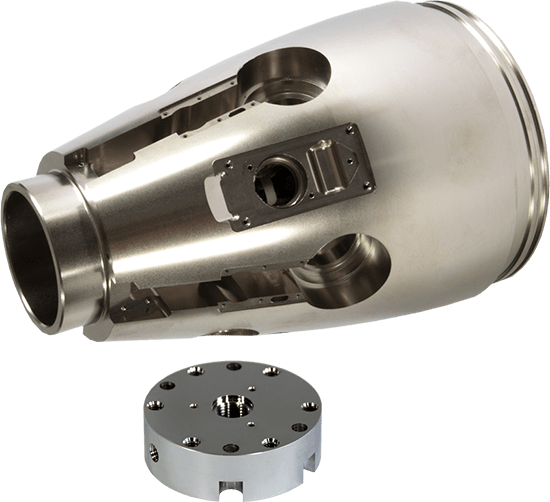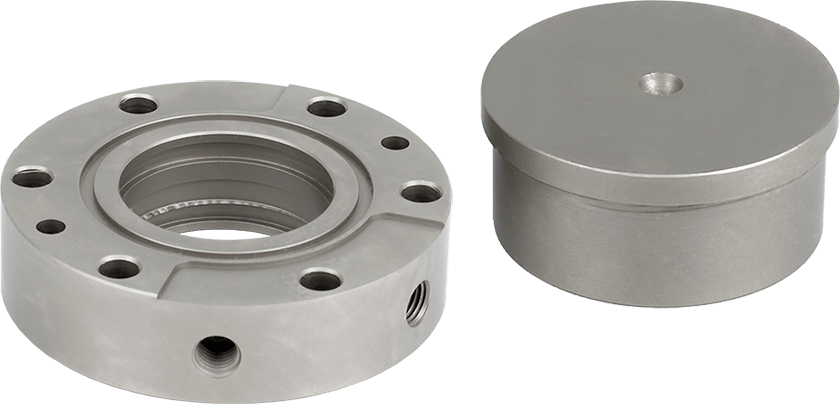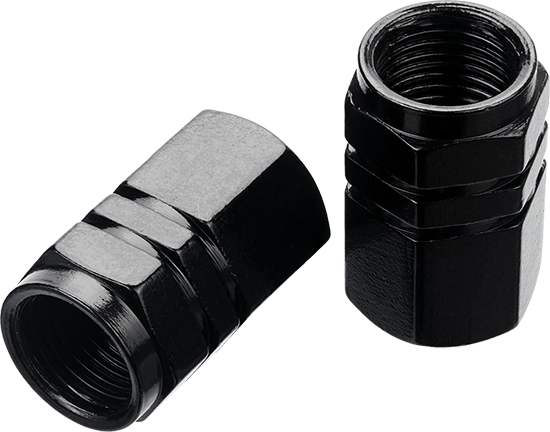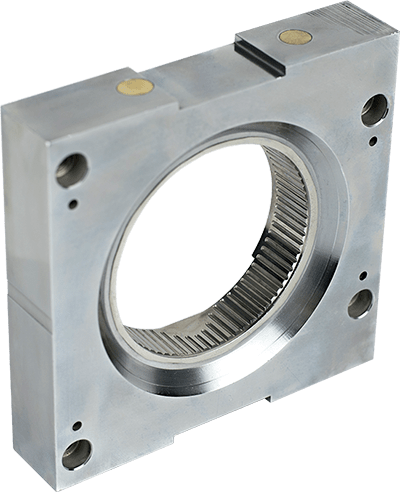Nickel Platings & Coatings
Satin Nickel, Electroless Nickel, and Black Nickel Plating for Injection Mold Manufacturing
Electroless Nickel Plating Services
Electroless nickel is an autocatalytic chemical reaction between the substrate and nickel solution, in an aqueous solution at nearly 200°F. Electroless nickel plates without electrical current, therefore the substrate has a uniform deposit no matter the configuration of the part. Electroless nickel is deposited in tiny molecular form sealing off the substrate from the environment.
This attribute is one of many reasons why it is the most requested coating for corrosion protection. (Unlike chrome where micro cracking takes place in the deposit) Electroless nickel plating services can evenly plate a hole as small as .020, and small grooves and deep bores are plated evenly as well. All of PFI’s electroless nickel baths are RoHS compliant.
PFI offers three electroless nickel baths
- High phosphorous electroless nickel for its excellent corrosion protection (salt spray test of 1000+ hours)
- Medium phosphorous for its hardness, brightness and fast plating rate
- Low phosphorous electroless nickel for its as plated RC hardness

Specs and Attributes
- Nonmagnetic properties
- Melting range is approximately 1600°F
- ASTM B 733-97
- Plating thickness from .000025 to .020
- PFI plates to MIL-C-26074 all classes and grades
- 48 – 52 RC as plated heat treatable to nearly 70 RC
- Number one corrosion protection on the market
- Improves wear characteristics
- Plates at 190-200°F
- MIL-26074
- AMS 2404C

Satin Nickel Plating
Satin nickel plating is excellent for corrosion protection, lubricity, and wear. In applications like plastic injection molds, having the uniformed plating deposit and a low luster appearance makes coating most steel materials effortless. Satin nickel has a .00005 – .0002 as the most requested deposit, but a thicker deposit up to .0007 can be applied as well. Satin nickel has a plated hardness of approximately 42 – 44 RC. These attributes are some of the many reasons why satin nickel is the popular choice for corrosion protection.

Black Nickel Plating
Black nickel provides outstanding protection against corrosion and wear as a result of its uniformed plating deposit of .0003 – .001, which allows all stainless-steel materials to be coated. With a plated hardness that is approximately 54 – 56 RC, it makes a superior solution for corrosion protection as opposed to other options. These attributes are some of the many reasons why choosing an experienced company, such as PFI, is crucial for black nickel plating for injection mold manufacturing.


Salvage with Hard Nickel Plating
- Improves wear
- Melting range is approximately 2340°F
- Plating thickness from .000025 to .015
- 58-62 RC as plated heat treatable to nearly 70 RC
- Excellent for corrosion protection, especially in alkaline environments
- Excellent substitute for hard chrome because of plating uniformity
- The same adhesion factors as hard chrome but not as brittle
- Most desirable choice for salvage.
- Plate in one of more specific areas to the nearest .0001.
Nickel Coating | Nickel Plating FAQs
What are the Benefits of Electroless Nickel Plating?
Electroless nickel is one of the most versatile finishes, capable of meeting your needs from wear and corrosion protection to lubricity concerns. The uniform plating thickness of electroless nickel allows for tight tolerances to be achieved. “Electroless” plating avoids the snags of electroplating such as uneven buildup that can compromise threads and part tolerances, which can require post-process grinding. Electroless nickel offers some of the best corrosion protection of all plated metals. PFI Inc. offers electroless nickel solutions designed specifically to produce wear resistance, corrosion protection, or lubricity.
What can you Nickel Plate?
The alloy can be deposited onto a wide range of substrates, including:
- Carbon
- Stainless Steel
- High Alloy Steel
- Iron
- Aluminum
- Copper
- Brass
- Bronze
- Beryllium
Is there a Difference Between Electroless Nickel & Hard Chrome?
Some applications of electroless nickel offer 1000+ hours of salt spray corrosion protection. Hard chrome can only offer 24 hours. Hard chrome offers slightly better wear protection than an electroless nickel. PFI Inc. provides an electroless nickel process that provides similar wear resistance as hard chrome. Read more on the many differences between electroless nickel and hard chrome plating.
How Thick is Nickel Coating?
The normal applied thickness ranges from .00012″ to .0025″. Within this range, the base substrate will gain the characteristics of the alloy coating for the majority of applications. Some of the key factors determining the correct thickness include part value, surface finish and end functional use. When properly applied, the coating may be honed or polished without damaging the finish.
What is Electroless Nickel Coating?
Without the electrical current required for alternate plating options, a chemical bath solution is the only tool necessary to initiate the electroless nickel coating process. Electroless nickel coating starts with a chemical reaction; this chemical reaction leads to an even deposit of nickel-phosphorus (or, nickel-boron alloy) on the surface of whatever material, or substrate, you are a coating. This substrate could be plastic or any variety of metals. The chosen substrate then goes through a series of cleaning and autocatalytic reactions.
Is Nickel Coating Durable?
Electroless nickel coating is widely utilized for its hardness and durability. The alloy’s hardness can range anywhere from 150 HV to 700 HV depending on its application, which lends to its natural resistance to both wear and corrosion.
What Chemicals are Used in Electroless Nickel Coating?
The first chemical applied within the nickel coating process will depend upon what kind of nickel coating it is (i.e., phosphorus for a nickel-phosphorus alloy). Then, a catalytic reduction occurs between the nickel ion and sodium hypophosphite in acid baths.
What is the Difference Between Electroless Nickel Coating and Chrome Plating?
While both materials work well for an array of substrate materials, they differ in both process and benefits. For example, hard chrome utilizes an electrochemical bath to produce a plating that is smooth and functional. Hard chrome is also aptly named, as it is known for its hardness (falling somewhere between 68 and 72 on the Rockwell C scale).
Electroless nickel coating, on the other hand, relies on a chemical reaction rather than an electric current. This electroless process leads to greater durability and superior corrosion resistance, with the material landing closer to 63 on the Rockwell C scale.
Is Nickel Coating Less Expensive than Chrome?
In order to create the most even coating possible, chromium may need to be polished down in a way nickel-phosphorus doesn’t require, resulting in less overall use of materials when utilizing electroless nickel plating. It is generally accepted that electroless nickel coating is slightly less expensive than chrome plating.
What is the Difference Between Nickel Coating and Anodizing?
The biggest difference between electroless nickel coating and anodizing lies in the results they present. For example, nickel coating provides a smooth finish that is capable of being reapplied, and actually adds weight and changes the exterior dimensions of a surface or substrate. Anodizing, on the other hand, partially soaks into a surface, leaving a lighter, color-optional layer that may not be as even as nickel coating.
What is Black Nickel Coating?
Black nickel is an electrolytic nickel plating with a black surface color. It is often utilized for its corrosion-resistant properties and ability to maintain electrical conductivity while reducing surface reflectivity.
How Thick is Electroless Nickel Coating?
Due to its chemical process, electroless nickel coating typically does not exceed 0.1mm. In order to garner a thicker coat, electroplating would be required.